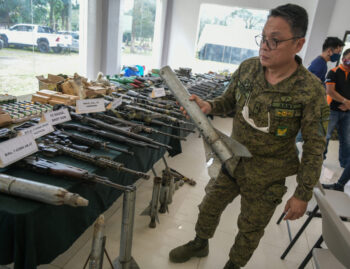NAAWAN, Misamis Oriental (MindaNews / 18 June) — The current public disclosure that Malacanang was aware of a Maute plan to attack Marawi City days before President Duterte and his key security executives’ trip to Russia raises disturbing questions:
Why did the Presidential entourage still leave the country despite the damning intelligence information? With such knowledge at hand, why did not the military launch pre-emptive strikes against the enemy right in their enclave to disable its war machines and capacities to terrorize the city? Why was the offensive against the terrorist group pursued only after the President has declared Martial Law in Mindanao when the enemy was already entrenched in the city?
 Defense Secretary Lorenzana considered the Marawi siege the consequence of military negligence and inaction, as a mis-appreciation of intelligence which basically means wrong assumptions on the strength and capacities of the enemy. The top executives of the Armed Forces of the Philippines (AFP) and Philippine National Police (PNP) apparently underestimated the enemy, considered as insignificant the threat of an impending siege, and thus joined confidently and happily the President, in what former President Ramos called the junket to Russia.
Defense Secretary Lorenzana considered the Marawi siege the consequence of military negligence and inaction, as a mis-appreciation of intelligence which basically means wrong assumptions on the strength and capacities of the enemy. The top executives of the Armed Forces of the Philippines (AFP) and Philippine National Police (PNP) apparently underestimated the enemy, considered as insignificant the threat of an impending siege, and thus joined confidently and happily the President, in what former President Ramos called the junket to Russia.
The planned attack did happen and Marawi fell without any resistance into the tentacles of the ISIS-Maute terrorists. The top guns were forced to abort or shorten the Russia sojourn and President Duterte had to declare Martial Law in the entire of Mindanao while still outside the country in response to the Marawi siege. Why he declared Martial Law for the entire island and not just in the confines of Marawi or at most of Lanao del Sur, and why the offensive against the enemy was pursued only after the declaration is for everybody to speculate.
At any rate, the mis-appreciation or misplaced assumptions about the enemy forfeited the opportunity to prevent the otherwise preventable very costly Marawi Crisis.
Truly, assumption is the mother of f–cking failures and disasters. Misplaced assumptions went down to the battlefield which forcibly extended the duration of the war causing untold devastation of the city and the tragic displacement of its populace.
At the onset of the war, the military’s estimate of the Maute strength in the city was placed at 50 to 100 militants. The figure did not sound threatening then; such an enemy size could be quashed, accordingly, in three days to at most a week’s time.
An incongruous combat thus ensued. Waves and waves of ground assault troops supported with armored cars and war tanks rolled down towards Maute-held areas with the aim of finishing off the highly outnumbered militants in one sweep perhaps. But the Maute snipers scattered and invisible in high rise buildings held their ground. As the battle raged and the casualty mounted on both sides, the estimate of the number of armed militants in the city suddenly leaped to 500. Thereupon the ground troops were supported with massive air strikes; casualties began to climb on both sides, but gravely in the terrorist camp. The latest count is 226 dead terrorists, 58 dead soldiers plus 294 wounded in action and 26 unfortunate civilians caught in the exchange of fire. But wonders, despite the decimation of the enemy by reported massive death, desertion, capture and surrender, why is that the battle has remained intense and deadly of late, after three weeks of fire exchange?
The terrorists refuse to buckle down notwithstanding the deadly air strikes, barrage of artillery fires, and surging waves of ground assault troops. Hence, the deadlines on ending the war have kept on changing.
The rise in the casualty, the dead and wounded, in the government security forces and non-combatant population from enemy and friendly fire from the skies above and on the ground below, is perhaps reason enough for the military to rethink its current engagement strategy against the ISIS-Maute terrorists.
Isn’t it high time to unleash the military’s own snipers and commandoes to counter, hunt and drive the remaining militants out and away from the City? But does the military have this capacity in its human arsenal?
If it is wanting in such capacity, then the sad option to end the resistance is to continue the air strikes – to drop more and more bombs and pulverize the detected enemy positions with a complementary barrage of artillery fire on the ground. While this strategy may not totally annihilate the mobile terrorist militants, with everything around them woefully wrecked, with no more cover and nowhere to hide, they would be forced to leave the city. For a while, perhaps, the fighting may rage on, with the militants on the run back to their camp and elsewhere and the military in hot pursuit. But this would be in another place and terrain away from the ruins of Marawi.
When, this happens the reconstruction of Marawi can begin. Hopefully, a new Marawi, this time an intelligently planned urban city, will rise from the rubbles and ashes of the needless war. (MindaViews is the opinion section of MindaNews. William R. Adan, Ph.D., is retired professor and former chancellor of Mindanao State University at Naawan, Misamis Oriental, Philippines)







